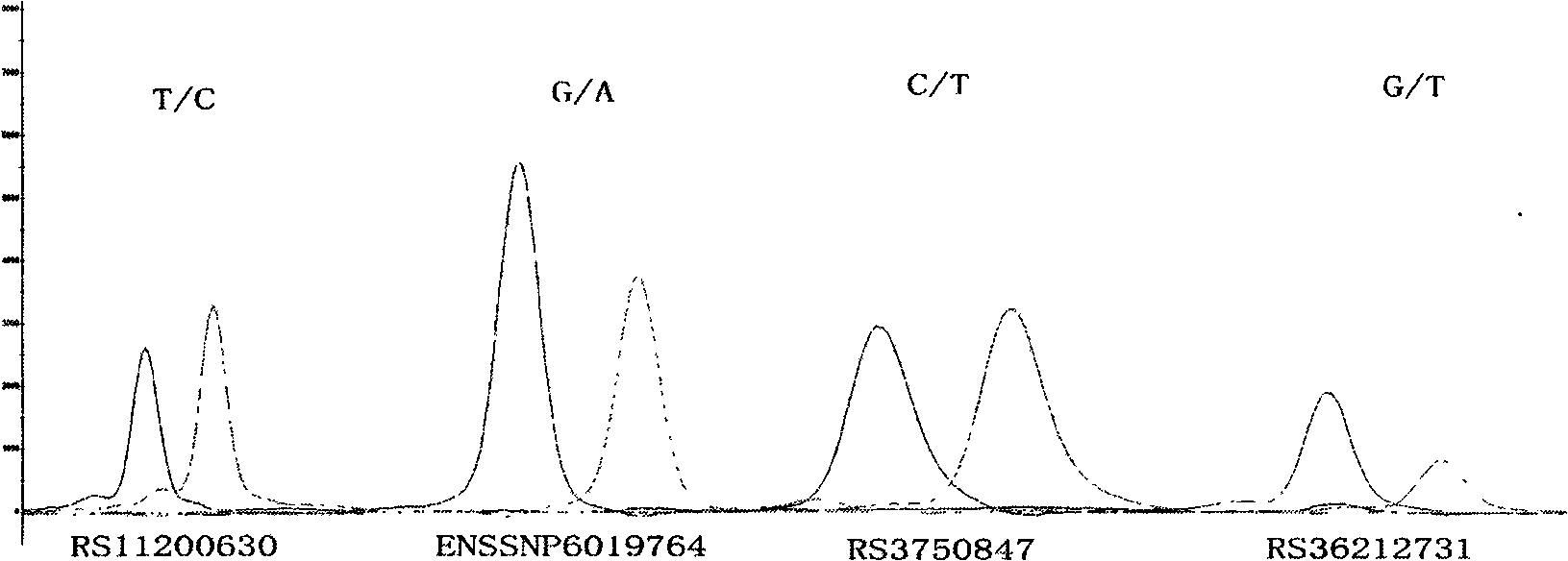Reagent kit for detecting agedness yellow spot degenerative disease
A technology for degenerative diseases and senile macula, applied in measuring devices, microbiological determination/inspection, instruments, etc., can solve problems such as poor results and difficult vision
- Summary
- Abstract
- Description
- Claims
- Application Information
AI Technical Summary
Problems solved by technology
Method used
Image
Examples
Embodiment 1
[0039] [Example 1] Blood sample collection and specimen processing
[0040] 214 Chinese patients with age-related macular degeneration (AMD) and 214 controls were selected. The patients were clinically diagnosed AMD, including 115 wet AMD patients and 99 dry AMD patients. The control group was a group of AMD patients who were older than or equal to 60 years old and had no drusen and retinal pigment changes.
[0041] A detailed investigation of the medical and family history of all participants, physical examination and detailed ophthalmological examinations were performed. After signing the informed consent form, each person collects 5-10ml of EDTA anticoagulant blood sample. The phenol-chloroform method was used to extract genomic DNA.
Embodiment 2
[0042] [Example 2] PCR amplification and genotype analysis of the 4340 base upstream deletion / insertion variant gene containing HTRA1 gene
[0043] (1) Electrophoresis separation and identification of PCR amplification products
[0044] 1. Take blood from the subject and extract DNA;
[0045] 2. Using 5’-GCCAACTGGAGCTTCTCATC-3’ and 5’-GTAGTTTCCAGGGGCTCTCC-3’ as upstream and downstream primers, PCR amplifies genomic DNA;
[0046] Reaction conditions:
[0047] 95℃3minutes, (94℃30seconds, 57℃30seconds, 72℃45seconds)*35cycles
[0048] 3. 1% agarose gel electrophoresis separation, based on the size of PCR product to distinguish deletion / insertion variation.
[0049] Agarose electrophoresis identification:
[0050] The PCR product containing the 4340bp deletion / insertion sequence upstream of the HTRA1 gene was separated by 1% agarose gel electrophoresis. The deletion / insertion made the normal fragment of the PCR product about 400bp smaller, and the genotype could be judged by electropho...
Embodiment 3
[0070] [Example 3] PCR amplification and genotype analysis of DNA fragments containing rs2293870, rs11200638, and rs10490924 SNPs
[0071] 1. Extract blood genomic DNA from AMD patients and control groups.
[0072] 2. PCR amplification of genomic DNA fragments containing the target sequence (rs2293870, rs11200638, rs10490924)
[0073] Primer sequence:
[0074] rs2293870: Forward: 5’-GGCCGCTCGGCGCCTTTGGC-3’
[0075] Reverse: 5’-CCCCGAAGGGCACCACGCAC-3’
[0076] rs11200638: Forward: 5’-ATGCCACCCACAACAACTTT-3’
[0077] Reverse: 5’-CGCGTCCTTCAAACTAATGG-3’
[0078] rs10490924: Forward: 5’-TACCCAGGACCGATGGTAAC-3’;
[0079] Reverse: 5’-GAGGAAGGCTGAATTGCCTA-3’
[0080] Reaction conditions:
[0081] rs2293870: 95℃3minutes, (94℃30seconds, 57℃30seconds, 72℃45seconds)*35cycles
[0082] rs11200638: 95℃3minutes, (94℃30seconds, 52℃30seconds, 72℃45seconds)*35cycles
[0083] rs10490924: 95℃3minutes, (94℃30seconds, 55℃30seconds, 72℃45seconds)*35cycles
[0084] 3. Geno...
PUM
 Login to View More
Login to View More Abstract
Description
Claims
Application Information
 Login to View More
Login to View More - R&D
- Intellectual Property
- Life Sciences
- Materials
- Tech Scout
- Unparalleled Data Quality
- Higher Quality Content
- 60% Fewer Hallucinations
Browse by: Latest US Patents, China's latest patents, Technical Efficacy Thesaurus, Application Domain, Technology Topic, Popular Technical Reports.
© 2025 PatSnap. All rights reserved.Legal|Privacy policy|Modern Slavery Act Transparency Statement|Sitemap|About US| Contact US: help@patsnap.com



